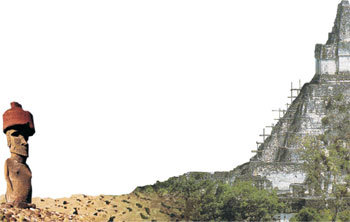Author Traces Fall of Civilizations
Author Traces Fall of Civilizations
Posted November. 05, 2005 03:02,

Easter Island is the remotest inhabited island in the world.
The sight of the huge stone statues and traces of stone stairs on this South Pacific island overwhelm those who see it. The largest statue is 21.3m tall and weighs 270 tons. Some Europeans still cant believe the fact that primitive Polynesians raised these statues.
Easter Island also is suffering from an extreme case of forest destruction. The destruction of the islands forest started right after humans arrived at the island in the 900s, and the forest was devastated by the time explorer Jacob Roggeveen reached the island in 1722. He could not find a tree that was taller than a human.
With the forests vanished, food that could be harvested from the wilderness also disappeared. The natives could not obtain anything from the trees and birds, and couldnt even make canoes to go out to the sea. Soon, even the birds disappeared. Fights frequently broke out due to famine, and the population level plunged. When Captain Cook arrived in 1774, there were only empty houses by the coast.
As the wild animals began to vanish, the islanders started to look for other sources of food. One source they adopted was human flesh. The remains of humans were not only found in graves, but also in garbage dumps. They also may have consumed human bone marrow, since cracked bones have been found.
The most inflammatory taunt that could be snarled at an enemy was: "The flesh of your mother sticks between my teeth.
Is there anything that makes us more anxious than the memories of a faded ancient civilization that only left traces of itself behind? Could we also share a similar fate someday? Or could future tourists visit what is left of New Yorks skyscrapers?
Jared Diamond, a world renowned authority in evolution biology and biogeography, analyses the ecological intricacies of the collapse of civilizations and categorizes the basic pattern of catastrophes that brought down the civilization in his book Collapse: How Societies Choose to Fail or Succeed, published in 2004.
He lists these patterns as: environmental destruction, climate change, hostile neighbors, friendly yet unstable trading partners, and societys response to environmental problems.
The collapse of Easter Island was purely ecological. Due to its excessive use of resources, it collapsed on its own. It had no hostile neighbors or any type of climate change to deal with.
The collapse of the Mayan civilization also followed in the footsteps of what happened to Easter Island. The primary reason for the collapse of the Mayans was environmental destruction caused by overpopulation. The Mayans faced the same dilemma facing modern Rwanda and Haiti. There are too many farmers, in a too large area, growing too many crops. The disproportion of population and resources led to the destruction of forests, loss and erosion of the soil, lack of food, and finally, war. As the author says, the collapse of the Mayans and Easter Island is no longer a romantic mystery.
The writer disagrees with those offering an Eden-like environmentalist opinion, that ancient natives respected the environment and lived an ecologically balanced life. In his opinion, the natives were already collapsing before the foreigners invaded.
However, why did only some societies fall apart? In Greenland, Norwegians and Inuits co-existed, but only the Inuit society managed to survive. Why is that so?
The descendants of Vikings stuck to the European way of life, refusing the way of life required to survive in a frozen land, and in the end they starved to death. Those traits also prevented them form making the drastic lifestyle changes and selective adoptions of Inuit technology that might have helped them survive for longer
Disasters are continuing to occur in modern world too. Somalia and Rwanda are showing concrete signs of collapse. Rwanda just shows to the naked eye the catastrophe predicted by Malthuss: An Essay on the Principle of Population.
China, a third world giant charging toward the first world, has environmental problems and an economy that has become the detonator of the world.
Not even the U.S. is safe. The state of Montana, that provided the breath taking scenery for the movie A River Runs Through It, was once the countrys richest state, but became one of the poorest due to environmental trouble.
After finishing a journey through past and present civilizations, the writer asks the readers, What were Easter Islanders saying as they cut down the last tree on their island? How could a society fail to have seen the dangers that seem so clear to us in retrospect?
Gi-U Lee keywoo@donga.com







